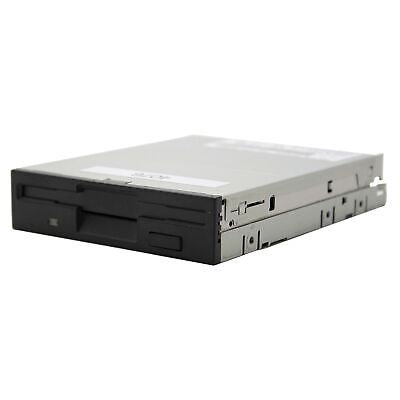An External Floppy Drive is a portable device that connects to modern computers via USB or other interfaces, allowing them to read and write floppy disks. Unlike traditional internal floppy drives, these units are encased in their own housing and draw power through the same cable used for data transfer.
Most external floppy drives are designed for the 3.5-inch floppy disk format, though specialized models exist for 5.25-inch disks. They are widely used in niche IT hardware setups that require compatibility with older storage media.
Why Use an External Floppy Drive in Modern IT Hardware?
Despite its age, the floppy disk still appears in various IT hardware workflows. Here’s why:
-
Data Recovery
Many organizations have archived data stored on floppy disks. An external floppy drive allows IT technicians to retrieve this information from older computer hardware. -
Legacy Software and Hardware Support
Some industrial equipment, scientific instruments, and manufacturing machines still use floppy disks for firmware updates or data logging. An external floppy drive enables these systems to continue functioning without expensive hardware overhauls. -
Vintage Computing Enthusiasts
Collectors and retro computing fans rely on external floppy drives to load and preserve software for classic systems like the Commodore Amiga, IBM PCs, and early Macintosh models. -
Educational Purposes
Schools and museums sometimes use floppy drives to demonstrate historical computing technology.
Types of External Floppy Drives
External floppy drives come in several variations, depending on disk size and connectivity:
-
USB 3.5-inch Floppy Drives
The most common type, compatible with standard 1.44MB floppy disks, and works with most modern Windows, macOS, and Linux systems. -
USB 5.25-inch Floppy Drives
Less common and more specialized, these are used for older disks from the early personal computing era. -
Multi-Format Drives
Some models can read multiple floppy sizes and densities, catering to archivists who need broad compatibility. -
Specialized Industrial Drives
Designed for use in machinery or specialized IT hardware that still relies on floppy disk media.
Key Features to Look for in an External Floppy Drive
When selecting an external floppy drive for your IT hardware setup, consider:
-
Compatibility: Ensure the drive supports your operating system and desired floppy disk format.
-
Build Quality: Look for sturdy casings, as these drives are often used for valuable data recovery.
-
Read/Write Capability: Some external drives are read-only; choose one with write support if needed.
-
Transfer Speed: While floppy disks are inherently slow, USB 3.0 models can help speed up data transfer slightly.
-
Driver Requirements: Opt for plug-and-play models when possible to avoid complex driver installations.
Using an External Floppy Drive with Modern Computer Hardware
Most external floppy drives connect via USB, making them compatible with laptops, desktops, and even some tablets through adapters. To use one:
-
Connect the Drive via USB.
-
Insert the Floppy Disk gently into the slot until it clicks into place.
-
Access the Drive through your operating system’s file manager.
-
Transfer Files to or from the disk.
For older operating systems, you may need to install specific drivers, which are usually included with the drive or available from the manufacturer’s website.
Maintenance Tips for External Floppy Drives
To ensure your external floppy drive lasts as long as possible:
-
Keep Disks Clean: Dust and debris can cause read/write errors.
-
Avoid Extreme Temperatures: Heat and humidity can damage magnetic media.
-
Handle Gently: Floppy drives have delicate mechanisms that can be damaged by rough handling.
-
Store Properly: Keep both the drive and floppy disks in a protective case when not in use.
The Role of External Floppy Drives in Data Preservation
Archiving data from floppy disks is an important step in digital preservation. External floppy drives are often paired with specialized software to copy data into modern formats, ensuring information isn’t lost to disk degradation.
In some IT hardware environments, these drives are part of a broader workflow involving tape backups, optical media, and network storage, providing a comprehensive data preservation strategy.
Advantages of External Floppy Drives
-
Portability: Can be used across multiple systems without permanent installation.
-
Ease of Use: Plug-and-play capability for most modern computer hardware.
-
Cost-Effective: A simple solution for accessing old data without expensive upgrades.
-
Legacy Support: Maintains compatibility with older IT hardware systems.
Limitations of External Floppy Drives
While external floppy drives are useful, they also have limitations:
-
Low Capacity: 1.44MB per disk is tiny compared to modern storage options.
-
Slow Speeds: Data transfer is significantly slower than USB flash drives.
-
Fragility of Media: Floppy disks are prone to damage and data loss over time.
The Future of External Floppy Drives
Although their mainstream use has faded, external floppy drives will likely remain relevant in niche markets for years to come. As long as industries and collectors have valuable data stored on floppy disks, the demand for these devices will persist.
Manufacturers may continue to produce them in small quantities, possibly with enhanced durability or hybrid functionality for other legacy formats.
Conclusion
The External Floppy Drive is more than a piece of nostalgia — it’s a practical tool for specific IT hardware and computer hardware needs. Whether you are retrieving decades-old research data, maintaining industrial machines, or exploring vintage computing, this device bridges the gap between old and new technologies.
By understanding its role, capabilities, and limitations, you can make informed decisions about integrating an external floppy drive into your modern IT workflow. Even in a world dominated by cloud computing and high-speed storage, there’s still a place for this humble yet essential piece of computing history.

